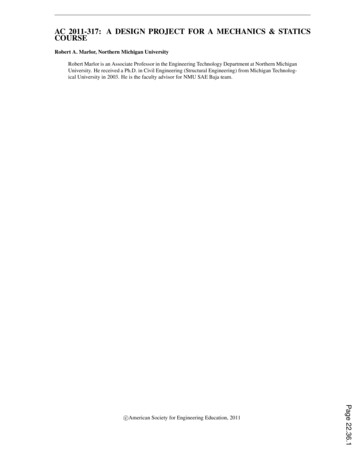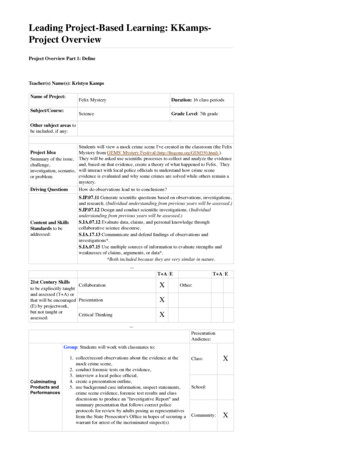
Transcription
AC 2011-317: A DESIGN PROJECT FOR A MECHANICS & STATICSCOURSERobert A. Marlor, Northern Michigan UniversityRobert Marlor is an Associate Professor in the Engineering Technology Department at Northern MichiganUniversity. He received a Ph.D. in Civil Engineering (Structural Engineering) from Michigan Technological University in 2003. He is the faculty advisor for NMU SAE Baja team.Page 22.36.1c American Society for Engineering Education, 2011
A Design Project for a Mechanics and Statics CourseIntroductionWhen teaching engineering design concepts in engineering technology programs, instructors arechallenged to create realistic, hands on, intuitive design experiences at an early stage in thestudents‟ development. This paper describes a balsa wood truss design competition used in aStatics & Mechanics course to motivate the learning of the concepts of static equilibrium andtruss analysis.Balsa wood bridge projects have been used to promote learning at several educational levels. Inthis particular student design project, the student must first analyze the forces in each member ofa truss, then determine the cross-sectional dimensions of each truss member and finally build andload test the truss. Over the course of more than twenty semesters, the details of this projecthave been refined to produce a realistic design experience that solidifies the learning of trussanalysis by requiring the student to both design and build a model truss.In this paper, detailed information will be presented on how to successfully incorporate thisproject experience into a Statics class in a time-efficient manner.Class ProfileThis project is used in a Statics and Mechanics course, for which the only perquisite is onesemester of College Algebra, thus this first course in which students experience the basic designprocess. The class size is typically 30 to 40 with a 50:50 mix of Engineering Technologystudents and Construction Management students in 4-year degree programs.Truss Design Project DescriptionThe objective of this truss design competition is for a team of two students to design and build abalsa wood truss bridge which will span 36 inches and hold a 24 lb point load. The span length,amount of the load, and location of the load vary each semester. The only material used is balsawood and glue. The lightest bridge to hold the 24 lb load is the winner, and the others are rankedbased on the ratio of load held to bridge weight. Only the applied load is measured, individualmembers forces are not measured during the test. The complete project rules can be found inAppendix A.While the basic design process is not overtly identified in this course, the methods of design areused. The students identify the design requirements (given to them), they develop potentialsolutions, and then they perform engineering analysis on the best solution to compare the meritsof the various designs. Each student first determines the member forces in two preliminary trussconfigurations using the Method of Joints and/or the Method of Sections. The students thendetermine the cross-section size required for each truss member, using a table of balsa woodmember capacities provided by the instructor (see Appendix B for an abbreviated version of thistable). By determining the volume of wood required for each truss, the students can compare thePage 22.36.2
weight of each truss design. The two partners then meet and decide which of the designs tobuild, by considering the truss weight, factors of safety, and ease of construction.Prior to building the bridge, each student submits a design report which includes a scale showingall truss dimensions, the member force analysis calculations, and the member size design. Themember size design can be summarized in a single table as shown for a simple three membertruss in Table 1.Member ForceNumber (lb)ABAC8.3 C10.0 TLength Size(in)(in x in)Capacity Safety(lb)Factor101/4 x 1/419.3201/16 x 1/8 26.6Table 1: Truss Design Summary2.32.7Volume(cu in)0.6250.156Project ScheduleThe truss project is introduced into the Statics course in the eighth week of a fourteen weeksemester, as the topic of Truss Analysis is being covered. Preliminary design sketches (showingall dimensions, but no member forces or sizes) are then due in the ninth week. Once the topic ofTruss Analysis has been introduced, students can begin to analyze the forces in their preliminarydesigns. A design report showing the truss analysis calculations and member size selections isdue in week 11, and then students are paired with a partner and asked to compare the merits oftheir two designs. The students then decide which truss design to build, then each student isrequired to build one of the two truss panels used in the bridge. The individual truss panels aredue in week 13, which gives each team one week to connect the two panels together in time fortesting in the fourteenth week.Team SelectionA successful truss design and build project is highly dependent upon the students‟ constructionskills. A team comprised of two students with strong academic abilities will usually produce anexcellent bridge design, but the bridge will not hold the full design load if it is constructedpoorly. Conversely, a pair of students with below average academic abilities, and goodconstruction skills will tend to produce a poorer design report, but will partially compensateusing very good construction technique. The best teams are those that combine good design withgood construction, so it can be beneficial to build teams based upon a combination of academicability and construction skills. Quiz and test scores garnered in the first seven weeks can be usedto identify the students with the strongest academic abilities and simple questionnaire is used todetermine construction and fabrication abilities.Grading and Progress MonitoringPage 22.36.3A schedule of project submittals and a grading system have been successfully used to monitorthe students‟ progress and to encourage a relatively equal sharing of the work load for each of
the two team members. The project grade accounts for 20% of the class grade. One half of theproject grade is based on the design report and is graded individually; the other half is based onthe performance of the bridge and a final report and this grade is assigned to the team. The twoweeks allotted for preparing the design report has consistently proven to be an adequate amountof time, and a heavy penalty of 10% per day late is levied to keep the project on schedule.The second two weeks provided for building the truss provides enough time for students to meetto decide upon a final design and build the truss panels. Each student is responsible forsubmitting one of the two truss panels used in the bridge, and this individual accountability hassuccessfully kept all but a few projects on schedule.One week is left for connecting the two truss panels together and then the bridges are tested. Thebridge performance grade is 40% of the project grade and is determined by ranking the load-toweight ratio of each bridge. One percent is deducted from the performance grade for each placea given bridge is lower in the standings. Thus, for a class with a total of 25 teams, the lowestpossible performance grade is 76 percent. The objective of the performance grading system is toencourage students to optimize the design by making the truss as light as possible, whileincluding a reasonable factor of safety to account for the variability of construction quality andbalsa wood strength.A final report is worth 10% of the total grade and is submitted on the day of testing. This reportsummarizes the students‟ logic for selecting one design over another, including a comparison oftruss weight, factors of safety, and ease of construction.Construction Techniques and MaterialsIt is important to emphasize the importance of building a straight and square truss. If a truss isbowed, skewed, or twisted, it will hold only a fraction of its full design strength. One way toenable good truss construction is to draw a full scale sketch of the truss on a sheet of paper, thenbuild each truss panel on top of the sketch. The top and bottom chord members are placed on thepaper first, with tape or a drop of glue to hold them in place, and the web members are then cutto length with a knife or scissors by first holding them in position over the chords to mark thelocation and angle of the cut. This provides a nicely mitered joint, which can then be reinforcedwith 1/16” thick plates cut from balsa wood sheet stock.The top and bottom chord members are best constructed by starting with one continuous lengthof balsa wood, and then laminating pieces to it in the middle region where the higher loadsrequire a thicker cross-section. It is very difficult to construct straight chords by piecing themtogether in shorter lengths from joint-to-joint.To keep the bottom chords parallel when connecting the two truss panels together, one can tapethe chords to a sheet of paper with two parallel lines drawn on it. To keep the truss square andplumb, the trusses can be held in a vertical position with a carpenter‟s square or other rectangularobject while the cross members are glued into place. In addition, all cross members should becut to the same length.Page 22.36.4
Balsa wood is available in 36-inch and 48-inch lengths from most local hobby supply stores, butfor the quantities used for a class of over thirty students, it is best to either order the balsa woodonline or to place an advance order with a local hobby supply store. To simplify ordering andstocking, one can limit the purchase to 1/16”, 1/8”, and 3/16” square stock and 1/16”x 2” sheetstock (for connection gussets).Most members sizes can be built (laminated) from combinations of the three square sizesindicated above (e.g. a 1/4” square member can be built from four 1/8” square members). Sincethe strength and stiffness of balsa wood are highly variable, laminating members dramaticallyimproves their strength reliability.Students are also encouraged to perform a simple flexure test on their balsa wood to cull out theweaker pieces. To test the balsa stock, all pieces of a given size are cantilevered the samedistance off the edge of a table, then a coin is hung from the end of each member and thedeflection is measured. The weaker pieces of balsa wood will deflect much more, so precisemeasurements are not necessary.Cyanoacrylate (CA), commonly known as Super Glue, is used for connections. Using CA savesconstruction time because it cures so quickly. Joints can be glued by simply holding themembers in place for a few seconds. Larger bottles of CA are available from hobby stores, andare much easier to use than the small squeeze tubes more commonly available in stores.Load TestingThe bridges are load tested in a public area to generate student interest. Each bridge is weighedby an official, and then impounded for protection. The loading apparatus is relatively simple;please refer to Figure 1 for a photo of the testing apparatus. Two tables are placed 36 inchesapart and leveled. A 1.0” square steel tube is placed on top of the bridge to distribute the loadbetween the two truss panels, and a bent steel rod with a circular plate welded to the bottom isused to hold a series of 2 lb weights. A 2.0‟x2.0‟ square piece of plywood is placed below theload to dampen the impact generated by the weights should the bridge fail. An alternative tousing the bent rod and weights is to suspend a bucket from the bar with rope or cable and havethe students fill the bucket with sand or steel shot. Each team places its bridge across the twotables, and then places the loading apparatus on the bridge. At this point shims can be placedunder one of the four supports if the bridge is not resting evenly. The students then have fiveminutes to load the bridge.AssessmentIn course evaluations, students frequently comment that this project gives them a much deeperunderstanding of force analysis and Statics as a whole. Since this course project has been usedevery semester the author has taught the course, data is not available to compare student learningfor students that did not participate in the project. The course assessments have not addressedhow well the students‟ knowledge of the static analysis and the design process is enhanced bythis project, but this would certainly be valuable information to collect in the future.Page 22.36.5
Figure 1: Load Testing ApparatusSummaryThis project can be a valuable learning and motivational tool in a Statics course. Studentcomments in course evaluations consistently rate this project as their favorite part of the course,so the motivation to learn is definitely enhanced through this project activity.The details provided in this paper will enable the instructor to implement this project withminimal preparation time, while using relatively little class time.Page 22.36.6
Appendix A – Truss Design Competition RulesThe rules used for the truss design competition in the author‟s Statics course are included on thefollowing three pages:The object of this competition is to design and build a structure which is capable of supporting aload of 24 lb in the center of a 35” clear span, with 1/2” overlap at each support.The material shall be balsa wood. The structure must be three dimensional and capable offitting in the testing fixture provided. Maximum points for the testing portion of the grade willbe awarded for the lightest structure which will support the full load. Bridges will also be gradedon the bridge's structural efficiency (Max. load supported/weight of bridge).Students will work in teams of two. It is expected that the work will be shared equally betweenteam members. The Design Report will be graded individually for each student, but teammembers will receive the same grade for the testing portion of the project.Page 22.36.7
Construction Details: No materials other than the balsa wood ma
The objective of this truss design competition is for a team of two students to design and build a balsa wood truss bridge which will span 36 inches and hold a 24 lb point load . The span length, amount of the load, and location of the load vary each semester. The only material used is balsa wood and glue. The light est bridge to hold the 24 lb load is the winner, and the others are ranked .











